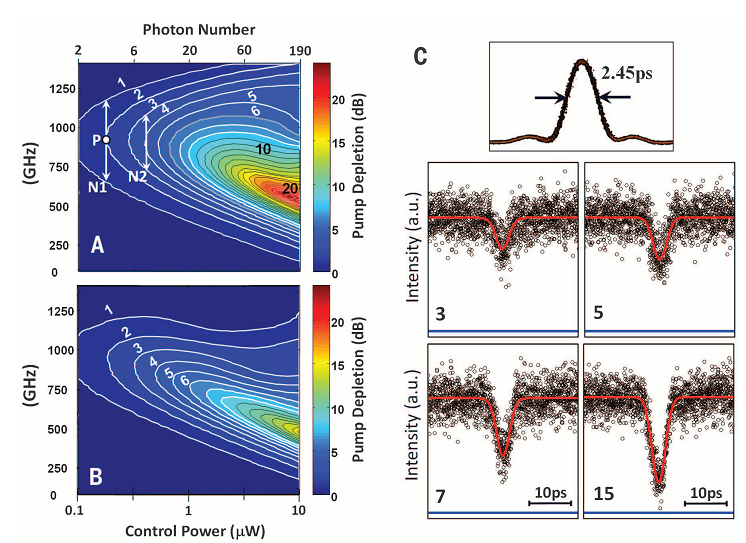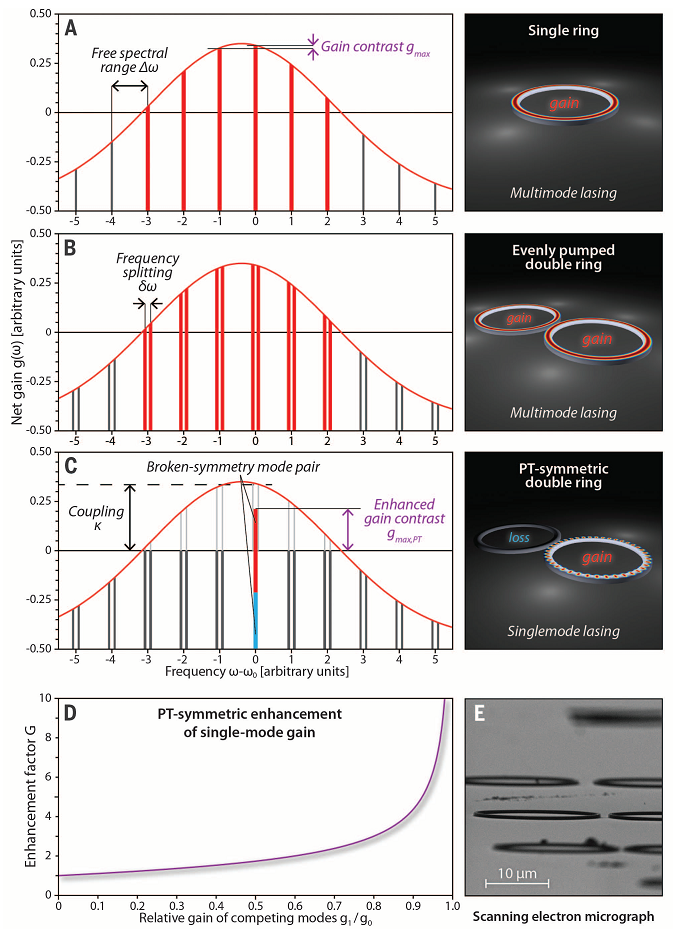Doi: 10.1126/science.1253125
Published: 2014.06.25
内容介绍:
在量子传感器件及光学处理器件中,如何用几个光子超快控制一束强光是公认的难点和瓶颈。这里,我们利用设计过的,分子精度的光纤,实现了一种有效快速的光学门。我们利用局域控制,nm精度粗糙度的光纤实现了分布式高效的光子-光子相互作用。3个光子的输入光可以以500GHz的速率调控W量级的强光。除了可用于超快调控,我们的实验结果还可以用于超高采样率超高灵敏的传感探测。

图1 优化直径后光纤的光学开关
(A)虚线和实线分别是计算和实际用于实验的光纤直径函数。横坐标是光纤的长度,纵坐标是光纤直径相对与平均值的偏离。实验中所用的光纤是根据理论计算,从光纤库中找出适合的两段拼接而成,拼接位置在z=245.2m处
(B)稳态和快速开关的实验装置图。强的泵浦光(连续)和弱的的信号光(连续或者脉冲)合成一起耦合进非线性光纤

图2 稳态和超快光控制响应
(A)实验所测得的对泵浦光的‘带宽耗尽地图’。1dB耗尽对应3个光子(N1),3dB耗尽对应8个光子(N2)。泵浦/信号光之间频率间隔的探测精度是12GHz。信号光能量步长按耗尽增多1dB来变化
(B)四光子混合过程的不可逆性。是将泵浦光和信号光反向后得到的‘带宽耗尽地图’
AB两图的横坐标下面是控制光(信号光)的功率,上面是对应的带宽(时间)下的光字数
(C)2.45ps的控制光,分别包含3个,5个,7个,15个光子时,对泵浦光的耗尽情况。红线是平均值,蓝线是基底
Doi: 10.1126/science.1258480
Published: 2014.11.21
内容介绍:
如何控制激光器中的谐振模式是一个基本的问题。模式竞争对光束质量和频谱的纯度都不利,以致辐射强度时间和空间上的浮动。这里,我们利用宇称-时间守恒的概念,在耦合微环激光系统中,实现了稳定的单纵模输出。这种宇称-时间守恒破缺,可以让所选择的纵模得到更大的输出能量;又由于是内部自适应的结构,不需要额外复杂的部件就可以在很大的波长范围内选择所需的波长。我们的实验结果给光电集成器件和结构提供了更强大的功能。

图3宇称时间守恒微环激光器模式压制原理
A:单环激光器,有多个纵模,当有净增益时,各个纵模均能起振。为了达到单纵模,泵浦功率受限于增益最大的纵模和相邻纵模之间的‘增益对比度’。对于单环,’增益对比度’很小
B: 双环激光器,相同泵浦条件。两环增益一致,原来的简并态劈裂成一对模式
C: 双环激光器,宇称-时间守恒泵浦,即只泵浦一个环。当两环之间的耦合大于两环的增益/损耗差,则处于宇称-时间守恒状态;反之则处于宇称-时间守恒破缺状态。利用这种机制,增大‘增益对比度‘,有助于在多纵模中产生单纵模激光
D:放大系数G(宇称-时间守恒结构下和单环结构‘增益对比度‘比值)与单环机构下增益对比度的关系,
E: 耦合微环腔的扫描电镜图
二、 简讯:
Doi: 10.1038/NPHOTON.2014.283
Published online: 2014.12.24
Abstract:
Colloidal quantum dots, viruses, DNA and all other nanoparticles have acoustic vibrations that can act as ‘fingerprints’ to identify their shape, size and mechanical properties, yet high-resolution Raman spectroscopy in this low-energy range has been lacking. Here, we demonstrate extraordinary acoustic Raman (EAR) spectroscopy to measure the Raman-active vibrations of single isolated nanoparticles in the 0.1–10 cm−1 range with ∼0.05 cm−1 resolution, to resolve peak splitting from material anisotropy and to probe the low-frequency modes of biomolecules. EAR employs a nanoaperture laser tweezer that can select particles of interest and manipulate them once identified. We therefore believe that this nanotechnology will enable expanded capabilities for the study of nanoparticles in the materials and life sciences.
Doi:10.1038/nature11567
Published: 2013.01.03
Abstract:
The time it takes to switch on and off electric current determines the rate at which signals can be processed and sampled in modern information technology. Field-effect transistors are able to control currents at frequencies of the order of or higher than 100 gigahertz, but electric interconnects may hamper progress towards reaching the terahertz (1012 hertz) range. All-optical injection of currents through interfering photoexcitation pathways or photoconductive switching of terahertz transients has made it possible to control electric current on a subpicosecond timescale in semiconductors. Insulators have been deemed unsuitable for both methods, because of the need for either ultraviolet light or strong fields, which induce slow damage or ultrafast breakdown, respectively. Here we report the feasibility of electric signal manipulation in a dielectric. A few-cycle optical waveform reversibly increases—free from breakdown—the a.c. conductivity of amorphous silicon dioxide (fused silica) by more than 18 orders of magnitude within 1 femtosecond, allowing electric currents to be driven, directed and switched by the instantaneous light field. Our work opens the way to extending electronic signal processing and high-speed metrology into the petahertz (1015 hertz) domain.
Doi: 10.1038/ncomms4246
Published 2014.02.05
Abstract:
The ability to use coherent light for material science and applications is linked to our ability to measure short optical pulses. While free-space optical methods are well established,achieving this on a chip would offer the greatest benefit in footprint, performance and cost,and allow the integration with complementary signal-processing devices. A key goal is to achieve operation at sub-watt peak power levels and on sub-picosecond timescales. Previous integrated demonstrations require either a temporally synchronized reference pulse, an off-chip spectrometer or long tunable delay lines. Here we report a device capable of achieving single-shot time-domain measurements of near-infrared picosecond pulses based on an ultra-compact integrated CMOS-compatible device, which could operate without any external instrumentation. It relies on optical third-harmonic generation in a slow-light silicon waveguide. Our method can also serve as an in situ diagnostic tool to map, at visible wavelengths, the propagation dynamics of near-infrared pulses in photonic crystals.
Doi: 10.1038/NNANO.2014.180
Published on line:2014.08.31
Abstract:
Biosensing relies on the detection of molecules and their specific interactions. It is therefore highly desirable to develop transducers exhibiting ultimate detection limits. Microcavities are an exemplary candidate technology for demonstrating such a capability in the optical domain and in a label-free fashion. Additional sensitivity gains, achievable by exploiting plasmon resonances, promise biosensing down to the single-molecule level. Here, we introduce a biosensing platform using optical microcavity-based sensors that exhibits single-molecule sensitivity and is selective to specific single binding events. Whispering gallery modes in glass microspheres are used to leverage plasmonic enhancements in gold nanorods for the specific detection of nucleic acid hybridization, down to single 8-mer oligonucleotides. Detection of single intercalating small molecules confirms the observation of single-molecule hybridization. Matched and mismatched strands are discriminated by their interaction kinetics. Our platform allows us to monitor specific molecular interactions transiently, hence mitigating the need for high binding affinity and avoiding permanent binding of target molecules to the receptors. Sensor lifetime is therefore increased, allowing interaction kinetics to be statistically analysed.
供稿人:徐颖鑫







